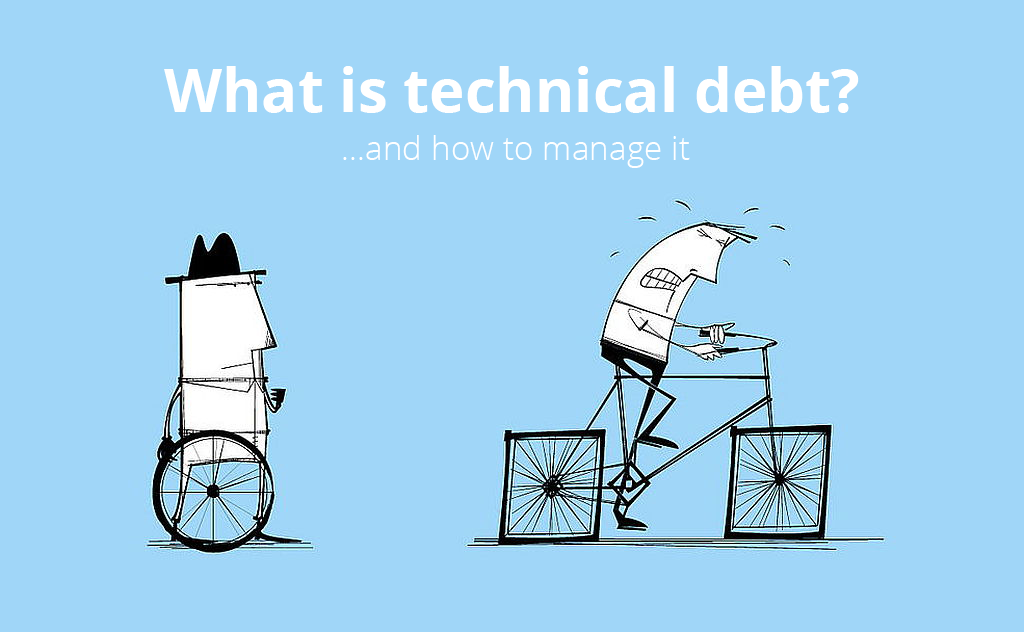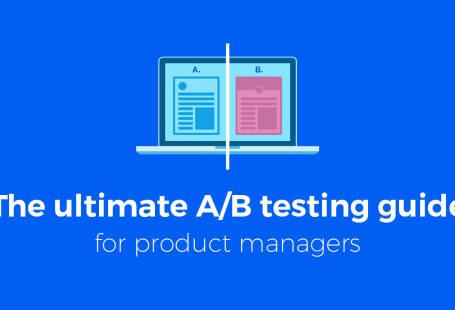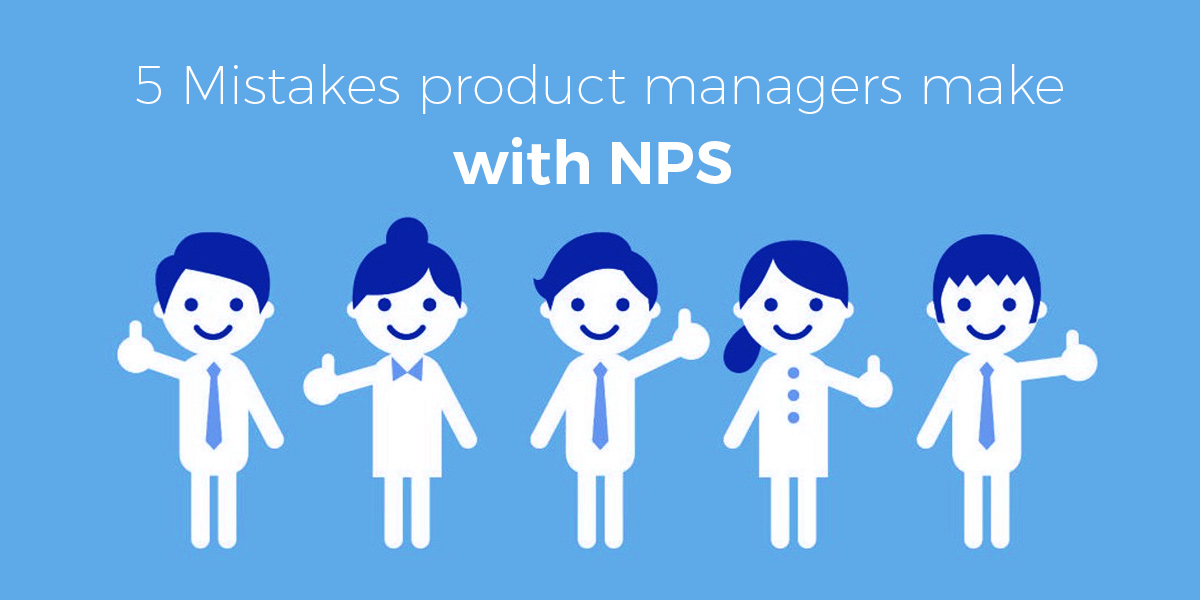
NPS is mostly used within a lot of mid-size to larger (tech) companies as part of their customer feedback metrics. In most cases, NPS is implemented and monitored by the product department. NPS is a great tool although it’s important to avoid some pitfalls.
In this article I’m going to give you 5 mistakes product managers make so you can avoid them (5 minute read). Say goodbye to these expensive mistakes!
What is NPS?
For those unfamiliar with the term. NPS stands for Net Promotor Score. It’s a well-known industry method use in a lot of companies to measure how well you’re doing with your current customers.
This is how it looks like:
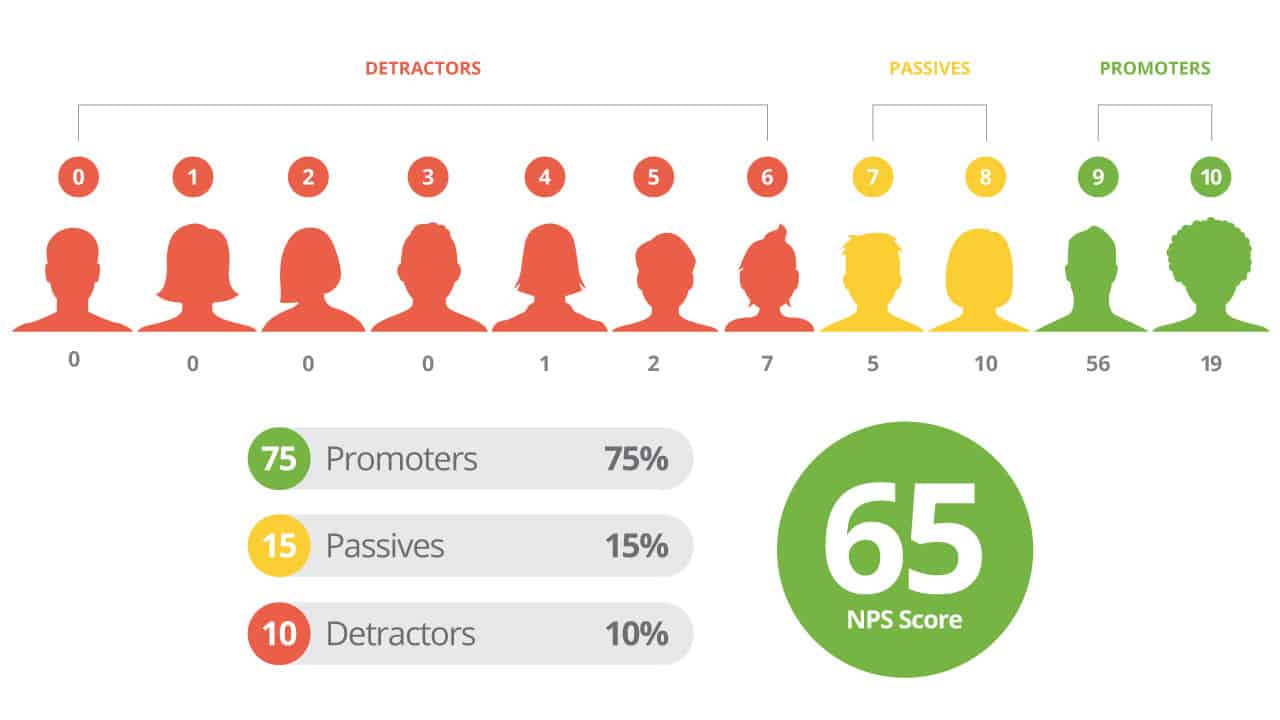
NPS segments your customers into 3 groups:
- Promoters: customers who scores 9 or 10. These customers are loyal to your product/brand and would recommend it to others.
- Passives: customers who scores 7 or 8. These customers find your product OK but they’re not loyal. They wouldn’t necessarily recommend your product to others.
- Detractors: customers who scores 6 or below. These customers don’t like your product (for any reason). They will tell others to avoid your product like the plague.
Determining a NPS score is usually done by calculating data from a customer survey. They’re not random questions but tailored for NPS scoring.
What question does NPS actually answer?
How likely will it be for you as a customer to recommend our product/service to a friend or colleague?
It’s important to understand what NPS is answering. NPS focuses on the likelihood of recommending your product. It actually means more than the eye meets:
- Customers who would recommend you put their social status on the line for your product. If someone recommends you some product and the product sucks, it will look bad on the person who recommended it in the first place. Putting social status on the line = brand loyalty.
- Customers who recommend you will probably remain long-term customers themselves. Unless you mess up pretty badly, your Promoters will stick with you for the ride.
- Customers who recommend you actually are part of your marketing mix Because they basically do your marketing (for free!) and word-of-mouth still remains the strongest piece of marketing out there, it can become an actual marketing channel in your marketing mix. You can activate or incentivize user to recommend your product. This adds significant value to your company’s bottom line in the long run.
Taking care of your customers and making sure that it’s easy for them to recommend you to others when they want to, can pay off in the long run.
The one thing you need to remember about NPS
NPS is a lot of work to implement and to get right. Implementing methods or frameworks just because other companies in your industry do it or to look cool, is a bad idea by default.
So here is the one thing you need to remember…
If you’re not serious about activating your Promoters to recommend your product, NPS will become a useless burden on your KPI sheet.
It will be like knowing your site traffic numbers without converting it into value like a subscriber, customer, etc. Just knowing these numbers will only lead to more meetings/discussions without results.
As we all hate more meetings, NPS should always be of operational and actionable value. If not, stay away from it.
Example of how to activate Promoters in product
I just want to show you an example of how Promoters can be activated. The rule is very simple: the easier it is to promote your product, the more likelihood you create that people will recommend your product.
DigitalOcean became a big player in cloud hosting with this method. They clearly understood that Promoters need to be incentivized and those who got their product recommended need a similar incentive to try-out their service.
This is how they activate their Promoters:
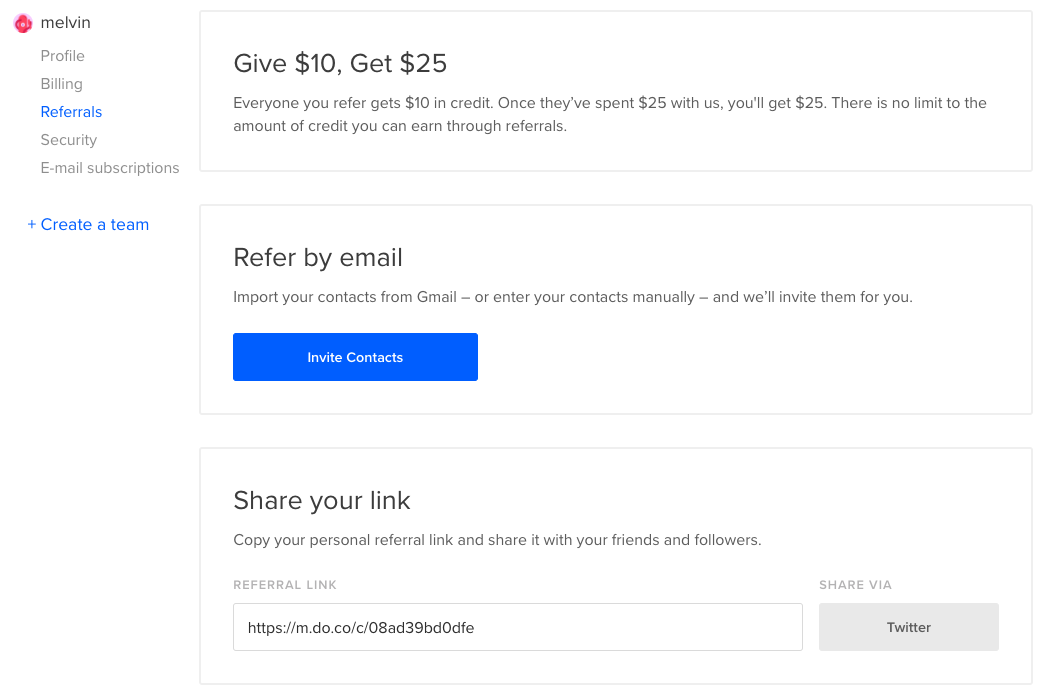
A few learnings from this example as a take away:
- The strongest method of activating your Promoters is incentivizing both them and those they recommend your product towards. It makes recommending your product worth while.
- Keep it simple. No complicated incentives (or badge) systems. If it’s not clear what kind of reward there will be, you’ll be making it harder for a Promoter to recommend you.
- You need to make it easy to distribute the recommendation by things like directly inviting contacts, providing a link to use, etc.
Mistake 1: NPS score as revenue growth indicator
NPS is sold as a method that ensures revenue growth. Based on my actual experience, that’s just not true in most cases. Think about it: if it was such a magical cure for revenue growth, everyone would be using it by now. That’s not the case.
It’s very important how you sell NPS to your management team. Context is everything with NPS. By perception it’s very easy to think that more customer satisfaction and likelihood of recommendation is directly correlated to (more) revenue. Implementing NPS is not that easy so in most cases management thinks that may expect revenue uplift as a return-on-investment of their NPS efforts.
Let me be clear: NPS is a high-level indicator on customer satisfaction and likelihood of recommendation. NPS can’t be used as any conclusion that suddenly more users will buy your product and therefor make more revenue. There are many other factors that decide for someone becoming a long-term customer.
If you sell it with growth intensions, chances are those numbers will not add up in the long run and will work against you from a management perspective (and can put your job on the line as you’re held responsible for those numbers).
NPS has no proven correlation to revenue or any return-on-investment for every business case.
Mistake 2: NPS as a product-only game
This mistake is easy to make for most companies. Because NPS is usually (partly) the responsibility of Product, it can be seen as an indicator where all factors are influenced by only the product itself.
The main responsibility of Product in this case is to expose product value with the least friction in the user journey as possible. A user may expect your product to be easy-to-use. That’s just one part of many other factors that influence NPS scores like:
- Marketing If you oversell your product and don’t deliver as advertised, your product experience is influenced by creating the wrong perception.
- Service Most online companies solve a specific problem, making you an expert in a certain field. This is mostly exposed when a customer hits trouble with your product and needs assistance of any kind. If your representative doesn’t expose this expertise, it will hit your NPS. People wan’t their problem solved, system or human. You should be on top of your game on every channel.
- Branding You can have the best product ever. But when your company is associated with bad practices or activities (like creating an expensive product that can be beaten by your own hands), you may forget any NPS score whatsoever.
And the list can go on-and-on.
I think you get the point of the story: NPS is not a product-only game. It’s a company-wide effort.
Mistake 3: NPS as main product KPI
This is actually a result of mistake number 2. When you consider NPS as a product-only game, it’s almost unavoidable you’ll get it as a main KPI (or OKR) for target setting. This not only makes number 2 worse but also puts NPS mostly out-of-context for all changes you see in the NPS score. That’s because product is always to blame for negative changes while it can be a non-product issue.
And when you don’t meet the KPI…your team begins to become demotivated as a result without them to blame as well. Be really cautious when attaching NPS to any KPI and think about this first.
Mistake 4: NPS becoming confirmation bias
If you read most articles on NPS you will feel a be dictated that you must only focus on the Promoters and neglect detractors/passives. In my experience that will become a dangerous habit.
I would agree to not lay any real focus on passives (very hard to convert into Promoters). The reason there are 3 groups is to give you an overview of how mainly promoters vs. detractors develop over time.
I’ve seen management only look at Promoters and come to often wrong conclusions that didn’t add up in there follow up steps. And guess what: in the end, it just doesn’t work.
The reason why it doesn’t work…because it fuels a human habit: confirmation bias. You start only confirming what is in favor of your own hypothesis and start neglecting any signal that disconfirms that perspective.
You’re basically seeing this:
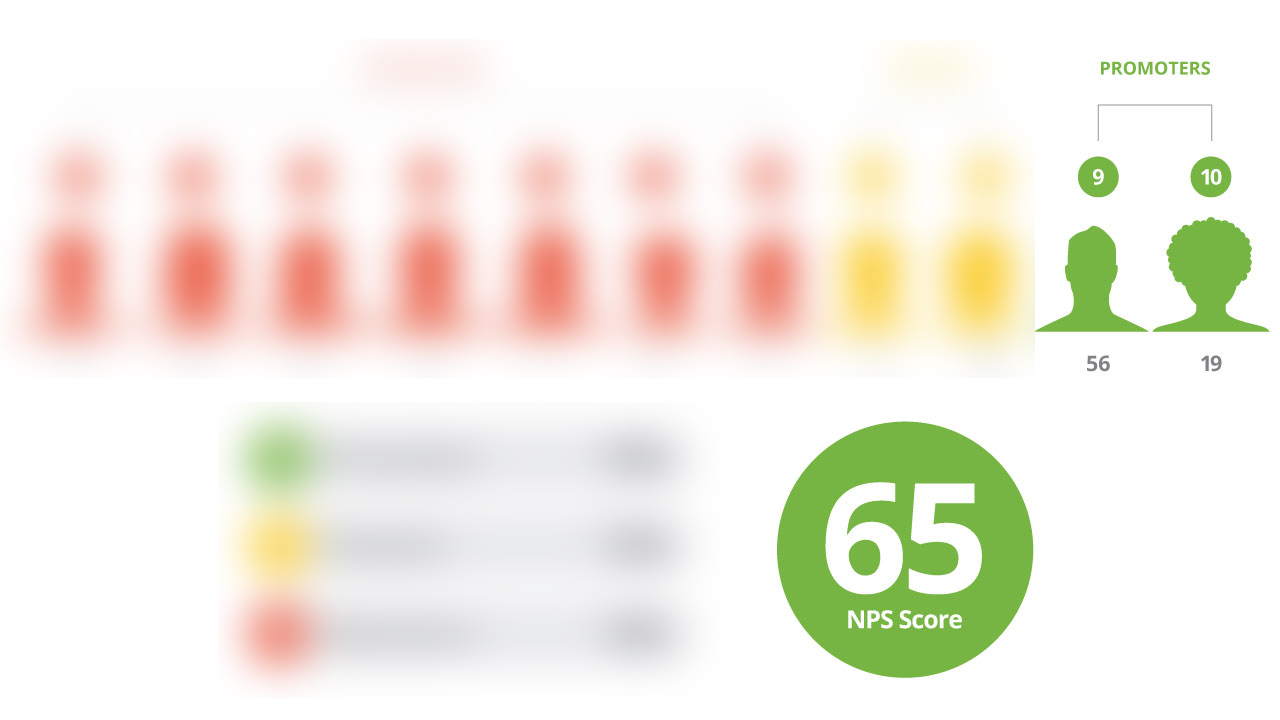
It’s important to consider NPS as an indicator across all those groups and dig deeper into the most influencing factors and answer ‘why’ a certain segment of NPS is really developing the way it does.
The first step towards answering those ‘why’ questions…is to keep the confirmation bias in check.
Mistake 5: NPS understanding by stakeholders
NPS by its concept is pretty straight forward to understand. The main issue with stakeholders arises when shifts in NPS score are interpreted in their own way by putting the NPS score in a different context. Mostly a context that will blame you as product manager for any decline in score.
Most stakeholders will say something like: “NPS score dropped X points in the last quarter so something is wrong with our product.”
It’s easy to put responsibility always on product. Remember, NPS doesn’t answer why your score is the way it is. It only puts out the effect, not the root. It can be a customer service problem (not helpful), marketing problem (overselling solution), etc.
Your job as a product manager would be to find the right context and put those stakeholders discussions about NPS into the right context. This way it’s more likely you’ll find the right root cause(s) of your NPS scoring and decide on the right actions to take on a company level.
NPS is not a holy grail for customer feedback
NPS may not be the holy grail for customers feedback or customer satisfaction but it definitely has value in your product development cycle.
My approach towards NPS as an asset to product management is pretty straight forward:
NPS should never be considered a goal but a timely measurement in the product feedback loop to identify challenges and opportunities for future product iterations.
NPS ultimately will only tell you something about the effect in a cause-effect relationship. It should act as a buy-in for teams to really think about what these NPS numbers mean.
Start with the cause by considering the effect indicator NPS gives you.
Enjoyed this article about NPS? Inspire your colleagues or business contacts by sharing this article.

